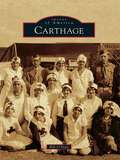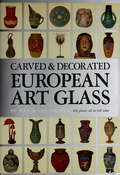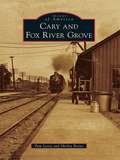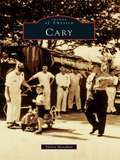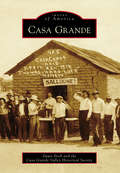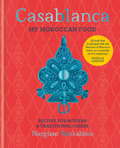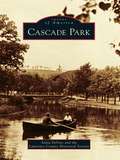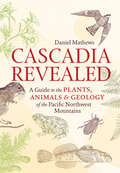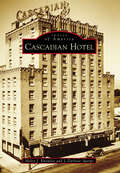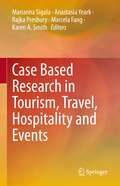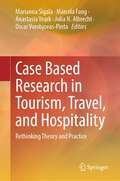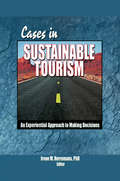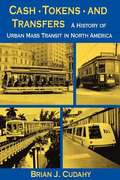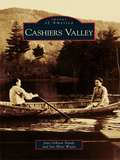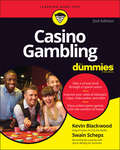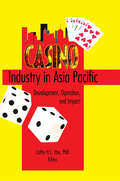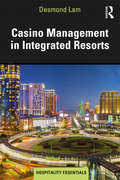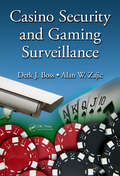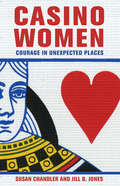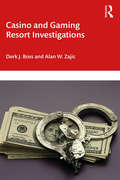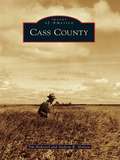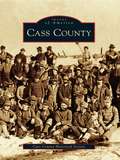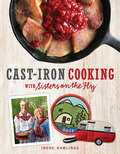- Table View
- List View
Carthage
by Bill O'NealFounded in a pine forest on the East Texas frontier, Carthage assumed the name of one of the greatest cities of the ancient world. Although Carthage, Texas, did not become a bustling metropolis, the community has enjoyed a long history as the type of stable town that forms the backbone of America. For more than a century and a half, residents have played roles--at times prominently--in the historical and cultural life of Texas and the nation. Carthage has produced decorated war heroes, internationally famous country music stars, a noted American historian, and a groundbreaking political figure. As the home of Tex Ritter, Gentleman Jim Reeves, Linda Davis, and the Texas Country Music Hall of Fame, the community has become a country music mainstay. Beyond its celebrities, however, Carthage has most importantly produced generation after generation of patriotic and hard-working men and women.
Carved & Decorated European Art Glass
by Ray Grover Lee GroverRarely has a book been accepted so quickly as a standard reference in the collecting field as Ray and Lee Glover's Art Glass Nouveau, which deals primarily with American aspect of this fascinating subject. Now, in an even more magnificent volume, the present similar detailed coverage of the art glass produced in Europe from 1880 to 1930.Again in full color, 424 plates beautifully portray the accomplishments of the outstanding French and English artist of this period. In very informative text, which is closely related to the illustrations, the Grovers identify the individual techniques of each of these artists.This magnificent book, like its predecessor, is a definitive work permanently available for reference. It, too, is a must for everyone requiring advanced as well as basic knowledge in the field of art glass.
Carved & Decorated European Art Glass
by Ray Grover Lee GroverRarely has a book been accepted so quickly as a standard reference in the collecting field as Ray and Lee Glover's Art Glass Nouveau, which deals primarily with American aspect of this fascinating subject. Now, in an even more magnificent volume, the present similar detailed coverage of the art glass produced in Europe from 1880 to 1930.Again in full color, 424 plates beautifully portray the accomplishments of the outstanding French and English artist of this period. In very informative text, which is closely related to the illustrations, the Grovers identify the individual techniques of each of these artists.This magnificent book, like its predecessor, is a definitive work permanently available for reference. It, too, is a must for everyone requiring advanced as well as basic knowledge in the field of art glass.
Cary & Fox River Grove (Images of America)
by Pamela J. Losey Shirley J. BeenePioneers built homesteads in the Fox River Valley between 1830 and 1850. They were attracted to the area that would become Cary and Fox River Grove by the beautiful scenery, abundance of clear water, and opportunity for waterpower provided by the river. The Fox River was the principle highway for Native Americans and these early settlers. It later attracted many residents of Chicago who spent their summers vacationing along its banks. The river provides outdoor recreational opportunities and is today the busiest waterway in the Midwest. The pages in this book bring to life the people, places, and historic communities--Fox River Grove to the south and Cary to the north, as well as Oakwood Hills and Trout Valley--along the Fox River.
Cary (Images of America)
by Sherry MonahanWhile a few people called the area we know as Cary home in the 1700s, it was not until 1854 that signs of a village began to appear. The enterprising businessman Allison Francis "Frank" Page bought 300 acres on which he operated a sawmill and did some farming. The railroad soon reached Cary, and in 1868, Frank saw the opportunity to start a new venture and built a hotel, which served meals and provided accommodations to train passengers. Cary was incorporated in 1871. By 1880, there were nearly 300 residents, and by 1930, that number had tripled. The timber industry kept Cary alive, as well as cotton gins and other manufacturing businesses. Cary had a private boarding school by 1870, and in 1907, it became the first publicly funded school and attracted students from around the state. Doctors, lawyers, merchants, churches, and many other businesses sprang up. However, it was the creation of Research Triangle Park that caused Cary's explosive growth.
Casa Grande
by Casa Grande Valley Historical Society Dawn SnellCasa Grande, Arizona, is located on desert and farmland between Tucson and Phoenix and began as the end of an unfinished railroad line--thus its early name, Terminus. On May 19, 1879, when early summer heat halted construction of the railroad in what would soon become Casa Grande, only three buildings and five residents constituted the town. The names reflect the ethnic diversity of the sparse population: Buckalew, Ochoa, Smith, Watzlavocki, and Fryer. In September 1880, executives of the Southern Pacific Railroad Company named the town Casa Grande after the prehistoric Hohokam Indian ruins located 20 miles to the east. This volume illustrates how a desert railroad stop grew into a city. Today, as Casa Grande's population increases, new neighborhoods, schools, malls, and entertainment venues provide exciting new reasons for living here. However, as the population grows, the town struggles to retain its identity as an agricultural community.
Casablanca: My Moroccan Food
by Nargisse BenkabbouOBSERVER RISING STAR IN FOOD 2018 'a book that is infused with the flavours of Morocco and is as accessible as it is inspiring' - Nigella Lawson 'It practically sings with aromatic spices and ingredients' - Delicious. 'Breathes new life into Moroccan food' - BBC Good Food Morocco is one of the top destinations in the world. This beautiful North African country lies on the border of Europe and the rest of the Arab world, drawing people in with its colourful souks, vibrant landscapes, cheerful hospitality and, most importantly, the food.Casablanca is the exciting debut from Moroccan chef Nargisse Benkabbou. This book features recipes for simple and satisfying dishes such as Artichoke, baby potato & preserved lemon tagine, Sticky ras el hanout & peach short ribs and Buttermilk chicken kebabs. Also featured are tasty western classics with a unique Moroccan twist: try your hand at Orange blossom, beetroot & goats' cheese galette, Roasted almond & rainbow couscous stuffed poussin and Moroccan mint tea infused chocolate pots.Nargisse breathes new life into Moroccan cuisine, blending that authentic Moroccan spirit and the contemporary to create accessible recipes for the everyday.
Cascade Park (Images of America)
by Anita Devivo Lawrence County Historical SocietySince its opening in 1897, Cascade Park has welcomed thousands of visitors to its picnic grove, summer cottages, mineral springs, dance pavilion, swimming pool, baseball field, zoo, boat rides, outdoor theater, fireworks, and numerous other amusements. The park is an unusually beautiful natural setting with Big Run Falls, Cat Rocks, a gorge, rolling hills, shady walkways, and even a ginkgo tree or two. In the 1890s, when it was called a trolley park, crowds of visitors arrived by streetcar. Eventually automobiles took over, and the roller coaster was dismantled to make space for a parking lot. Today automobiles spill out of the parking lot once a year when more than 1,000 vintage cars travel to the Back to the 50's Weekend, now in its 25th year. This and other family-oriented events continue the tradition of good times in Cascade Park.
Cascadia Revealed: A Guide to the Plants, Animals & Geology of the Pacific Northwest Mountains
by Daniel Mathews&“A love poem to the living things that inhabit the mountains and rivers of Washington, coastal Oregon, and southwestern British Columbia.&” —Saul Weisberg, executive director, North Cascades Institute More than just a field guide, Cascadia Revealed is the essential trailside reference for naturalists, hikers, and campers. With engaging prose and precise science, Dan Mathews brings the mountains alive with stories of their formation and profiles of the plants, animals, and people that live there. This is the perfect overview to help you discover the wonders of the region. Covers the Coast and Cascade Ranges, the Olympic Mountains, the Ranges of Vancouver Island, and the Coast Mountains of southwestern British ColumbiaDescribes more than 950 species of plants and animalsUser-friendly, color-coded layout, with helpful keys for easy identification
Cascadian Hotel (Images of America)
by Helen J. Knowles L. Darlene SpargoOn August 9, 1929, the Cascadian Hotel opened in Wenatchee, Washington, the "Apple Capital of the World." It was (and still is) the tallest building in town. The opening ceremony--featuring a human spider scaling the facade--celebrated the coming to town of a technologically innovative and luxurious hotel that, for its 42-year existence, prided itself on quality service. The Cascadian had very strong ties to the community, apple themes ran throughout the building, and for years it was the go-to meeting place in Wenatchee. The hotel also served as the starting point for the hospitality careers of several men and women who rose to executive leadership positions in the international Western (later Westin) Hotels chain.
Case Based Research in Tourism, Travel, Hospitality and Events
by Karen A. Smith Marianna Sigala Anastasia Yeark Rajka Presbury Marcela FangThis book consolidates international, contemporary and topical case study based research in tourism, travel, hospitality and events. Case studies can make learning more attractive and interesting as well as enable students to understand the theory better and develop their analytical and problem-solving skills. Using industry as an open living lab, case study based research infuses scholars into real-world industry challenges and inspires them to theorise and advance our knowledge frontiers.The book includes international case studies that can help tourism scholars build and advance (new) theories and enrich their educational practices. Case studies are accompanied with a teaching note guiding scholars to integrate case studies into instruction.Dr Kirsten Holmes, Chair, Council for Australasian Tourism and Hospitality Education (CAUTHE) There is a vital need for contemporary and well-structured case studies for use in tourism teaching. By including case studies from Australasia and key destination regions in Asia, Europe, and the Caribbean, the book is helpful for tertiary teachers globally. Professor Xander Lub, President, EuroCHRIE The book inspires educators and students. The cases provide context to students’ learning and demonstrate the richness and variation of the industry. The book also clearly demonstrates how research can inform our teaching. Professor Brian King, Chair, THE-ICE Assessment Panel The book includes cases under five themes: experiences, operations, technologies, strategy and marketing, and destinations. The book provides subject lecturers with a structure to guide students of applying theory into practice. Dr Paul Whitelaw, Academic Director, Southern Cross UniversityThis book marks a significant contribution to hospitality, tourism and events pedagogy at undergraduate and postgraduate level. At a time when the industry is demanding that our graduates have a strong grasp of “real world issues”, the case study approach provides an accessible, meaningful and relatable means by which students can engage in real world issues.
Case Based Research in Tourism, Travel, and Hospitality: Rethinking Theory and Practice
by Julia N. Albrecht Marianna Sigala Anastasia Yeark Marcela Fang Oscar Vorobjovas-PintaThis book consolidates case study based research in tourism, travel, hospitality, and events under one roof. It aims to consolidate cutting edge case study based research within the wider tourism industry that investigates topical and contemporary industry challenges and practices, which in turn can help tourism scholars to build new theory for advancing tourism research and educational practices. Case study based research is well recognised for its ability to develop theories and to support pedagogical aims. This book explores the repercussions of COVID-19 on tourism in how this has magnified the need and the urgency to use case based research and teaching. COVID-19 has accelerated profound changes in the tourism industry that are demonstrated in transformed: consumer profiles and behaviours; industry structures, business models and operations; and tourism labour markets. Subsequently, tourism educators, providers and researchers are required to study andaddress the abovementioned changes by undertaking transformational tourism research that can challenge and shift existing theories and knowledge frontiers, help industry and academia alike to reset new industry standards; and 2) develop tourism graduates that meet the new industry requirements, are resilient, flexible and adaptable, they possess transferable knowledge and skills that can solve real industry problems. The aim of this book to meets the market gap of books focusing on case study based research and teaching and further expands to address the COVID-19 repercussions and opportunities for tourism research and case studies.
Cases in Sustainable Tourism: An Experiential Approach to Making Decisions
by Kaye ChongMake sure your students are prepared for the difficult decisions they&’ll face every day in the tourism industryCases in Sustainable Tourism is a groundbreaking teaching tool that places students in real-life situations where they&’re faced with complex decisions on the economic, social, and environmental sustainability of act
Cash, Tokens, and Transfers: A History of Urban Mass Transit in North America
by Brian J. CudahyWritten by a transportation expert who knows how to bring his reader aboard, conduct a tour, and finally discharge all passengers safely, somewhere between history and nostalgia. -The Hudson Valley Regional Review.
Cashiers Valley
by Jan Blair Wyatt Jane Gibson NardyCashiers Valley, enveloped in the Blue Ridge Mountains with craggy stone faces, thundering waterfalls, majestic forests, and wilderness areas of unique flora and fauna, has always drawn visitors.Its moderate climate, slower pace, and friendly people have encouraged visitors to stay and, increasingly, to relocate. The residents have preserved a strong sense of place as they embraced the bonds of kinship and community through the years. This is all connected to a powerful religious base and a strong cultural heritage tradition. Today Cashiers Valley retains the charm of an isolated mountain village that welcomes guests. The photographs in this volume were gathered from manylocal scrapbooks, long forgotten and yellowing with age. Community residents are eager to share their photographs and memories of days gone by.
Casino Gambling For Dummies
by Swain Scheps Kevin BlackwoodMaximize your odds on the casino floor Casinos are designed for distraction, so it helps to know a bit about when the odds are in your favor and when they’re not before you push a stack of chips onto a table. Professional blackjack player Kevin Blackwood and lifelong sports bettor Swain Scheps know a thing or two about casino gambling. In Casino Gambling For Dummies, these seasoned gaming veterans guide you through the essential strategies for walking out of the casino ahead of the game. They also show you the most common mistakes made by players, helping you avoid gambling risks while you enjoy what the gaming industry has to offer. Learn to see past the flashing lights, decide how much you’re willing to wager, and find out how to enjoy yourself. In this book, you’ll also discover: Step-by-step walkthroughs of casino etiquette and the rules of common casino games, including poker and blackjack Explanations of video poker and slots and ways to avoid losing more than you’re comfortable with Explorations of online gambling, so you can enjoy the fun of a casino from the comfort of your home The perfect guide for anyone looking for an easy introduction to the world of casino gaming, Casino Gambling For Dummies is also an essential resource for those seeking to improve their odds at blackjack, craps, video poker, slots, and other games.
Casino Industry in Asia Pacific: Development, Operation, and Impact
by Kaye Sung Chon Cathy Hc HsuThis single volume gives you comprehensive information on Asia-Pacific gaming!Casino Industry in Asia Pacific: Development, Operation, and Impact is a one-of-a-kind comprehensive review of the gaming industry in various countries in the Asia-Pacific region. This valuable resource thoroughly details the history, the operational issues, and the impact of casino gaming in Australia, Korea, Macao, and Southeast Asia-and the Pachinko phenomenon in Japan. International authorities discuss crucial issues that involve policy makers and casino developers, allowing industry players a global perspective as they consider various important viewpoints in their long-range planning. Casino Industry in Asia Pacific is organized into three sections: Development, Operation, and Impact. Chapters in the Development section provide a thorough history of gaming for Australia, Japan, Korea, Macao, and Southeast Asia. Laws and regulations are also reviewed for each location. In the Operation section, each chapter analyzes an important casino operational issue, including regulations, licensing and due diligence, internal control and auditing, and rolling commissions. The last section reviews the economic and social impacts for various regions. Chinese culture and gaming are also examined in detail to illustrate the intertwined relationship between gaming and people&’s daily life. Extensive bibliographies, helpful tables, and fascinating photographs are also included.Casino Industry in Asia Pacific discusses: casino history and gaming legislation in Australia, Korea, and Macao Japan&’s form of gambling-Pachinko gaming in Southeast Asia suggestions for Asian gaming jurisdictions casino licensing investigations accounting, internal controls, and casino auditing the use of non-negotiable chips the societal and economic impacts of gaming in Australia the impacts of casinos in Korea gaming and Chinese cultureCasino Industry in Asia Pacific: Development, Operation, and Impact is an essential resource for graduate students, advanced undergraduate students, educators, researchers, gaming policymakers and lobbyists, concerned civic organization leaders and members, casino developers and executives, hotel professionals, travel and tourism professionals, and anyone interested in the gaming industry.
Casino Management in Integrated Resorts (Hospitality Essentials Series)
by Desmond LamCasino Management in Integrated Resorts introduces students to the changing nature of casino businesses within the framework of an integrated resort or hospitality organisation. In the new integrated casino model, casinos play an important role not only in revenue generation but in supporting the other amenities in the resort, including bars, restaurants, hotels and theme parks. This book brings readers up to speed with the challenges of managing a casino within this rapidly expanding gaming–leisure–tourism industry. It covers a range of essential topics, such as the basic psychology of casino gaming, the role and history of casinos within an integrated resort, staffing, floor design, table and slot game management, control and security, marketing and social impact. Written in an accessible style, this book is suitable for readers with no prior knowledge of, or experience in, casino operations. It will be an essential introductory yet comprehensive resource for all those undertaking casino management courses.
Casino Security and Gaming Surveillance
by Derk J. Boss Alan W. ZajicAlmost all incidences of cheating, theft, fraud, or loss can be detected through the surveillance of critical transactions, audit observations, and reviews of key metrics. Providing proven-techniques for detecting and mitigating the ever-evolving threats to casino security, this book covers the core skills, knowledge, and techniques needed to protect casino assets, guests, and employees. Drawing on the authors six decades of combined experience in the industry, Casino Security and Gaming Surveillance identifies the most common threats to casino security and provides specific solutions for addressing these threats. From physical security and security management to table and gaming surveillance, it details numerous best practice techniques, strategies, and tactics, in addition to the metrics required to effectively monitor operations. The authors highlight valuable investigation tools, including interview techniques and evidence gathering. They also cover IOU patrol, tri-shot coverage, surveillance audits, threat analysis, card counting, game protection techniques, players club theft and fraud, surveillance standard operating procedures, nightclub and bar security, as well as surveillance training. Complete with a glossary of gaming terms and a resource-rich appendix that includes helpful forms, this book covers everything surveillance and security professionals need to know to avoid high-profile incidents, costly compliance violations and damage to property and revenue. It‘s professionals like Al and Derk who personify the professionalism that is crucial when establishing and operating modern casino security and surveillance departments. This book will quickly become the Bible for any security and surveillance officer.
Casino Women: Courage in Unexpected Places
by Susan Chandler Jill B. JonesCasino Women is a pioneering look at the female face of corporate gaming. Based on extended interviews with maids, cocktail waitresses, cooks, laundry workers, dealers, pit bosses, managers, and vice presidents, the book describes in compelling detail a world whose enormous profitability is dependent on the labor of women assigned stereotypically female occupations—making beds and serving food on the one hand and providing sexual allure on the other. But behind the neon lies another world, peopled by thousands of remarkable women who assert their humanity in the face of gaming empires' relentless quest for profits.The casino women profiled here generally fall into two groups. Geoconda Arguello Kline, typical of the first, arrived in the United States in the 1980s fleeing the war in Nicaragua. Finding work as a Las Vegas hotel maid, she overcame her initial fear of organizing and joined with others to build the preeminent grassroots union in the nation—the 60,000-member Culinary Union—becoming in time its president. In Las Vegas, "the hottest union city in America," the collective actions of union activists have won economic and political power for tens of thousands of working Nevadans and their families. The story of these women's transformation and their success in creating a union able to face off against global gaming giants form the centerpiece of this book. Another group of women, dealers and middle managers among them, did not act. Fearful of losing their jobs, they remained silent, declining to speak out when others were abused, and in the case of middle managers, taking on the corporations' goals as their own. Susan Chandler and Jill B. Jones appraise the cost of their silence and examine the factors that pushed some women into activism and led others to accept the status quo. Casino Women will appeal to all readers interested in women, gambling, and working-class life, and in how ordinary people stand up to corporate actors who appear to hold all the cards.
Casino and Gaming Resort Investigations
by Derk J. Boss Alan W. ZajicCasino and Gaming Resort Investigations addresses the continued and growing need for gaming security professionals to properly and successfully investigate the increasing and unique types of crime they will face in their careers. As the gaming industry has grown, so has the need for competent and highly skilled investigators who must be prepared to manage a case of employee theft one day to a sophisticated sports book scam the next. This book provides the reader with the fundamental knowledge needed to understand how each gaming and non-gaming department functions and interacts within the overall gaming resort, allowing the investigator to determine and focus on the important elements of any investigation in any area. Each chapter delivers a background of a department or type of crime normally seen in the gaming environment, and then discusses what should be considered important or even critical for the investigator to know or determine in the course of the investigation. Likely scenarios, case histories, and tips, as well as cautions for investigators to be aware of, are used throughout the book. This book was written for and directed at gaming security and surveillance professionals, including gaming regulators, and tribal gaming authorities, who are almost daily confronted by the ingenious and the most common scams, theft, and frauds that are perpetrated in the gaming world.
Cass County (Images of America)
by Tim Hoheisel Andrew R. NielsenCass County is flanked on its eastern border by the Red River of the North. Created by retreating glaciers, Cass County is known for its exceptionally flat topography and fertile soils. Archaeological evidence indicates that the county was home to Paleo-Indian groups as far back as 9,000 years ago. More recently, many different Native American nations foraged and hunted bison in the region. Dakota Territory was created in 1861, and Cass County was organized in 1873 with Fargo recognized as the county seat in 1875. The county is named for George Washington Cass, a former president of the Northern Pacific Railroad, which entered the county in 1872. Cass County is famous for agriculture and its bonanza farms, enormous commercial wheat farms unique to the Red River valley from the 1870s to the 1890s.
Cass County: Scenes And Events At The Mouth Of Eel On The Historic Wabash; With Papers Read Before The Cass County, Indiana, Historical Society At Its Spring Meetings 1907 (Images of America)
by Cass County Historical SocietyIn 1849, the Leech Lake Agency for the Ojibwa peoples was established southwest of Agency Bay on Leech Lake. A government trail wound its way north through the wilderness from Fort Ripley to the agency. The establishment of this trail encouraged exploration and settlement of the area that became Cass County. Fur traders, explorers, and missionaries were followed by the lumber industry. The Ojibwas ceded their lands, which went up for public auction in the 1870s, and the logging companies purchased thousands of acres of these lands. By 1895, the Minnesota Logging Company was in the northern part of the county and built the Brainerd, Northern and Minnesota Railroad, which was sold to the Minnesota and International, which was the first railroad in Cass County. Small towns were platted out by town site companies and quickly settled by immigrants and others seeking new opportunities. Cass County presently has 15 villages and 50 townships. Tourism was first introduced into the county when a trainload of 300 tourists from St. Cloud arrived for a weekend of fishing on Leech Lake. Tourism is the county's number one industry today.
Cast-Iron Cooking with Sisters on the Fly
by Irene Rawlings“Good, honest, tasty food cooked up in a cast-iron pan or a Dutch oven . . . as easily prepared in a home kitchen as they are rustled up at a campsite.” —Edible PhoenixWith a motto of, “We have more fun than anyone,” Sisters on the Fly member Irene Rawlings introduces readers to the culinary comfort of cooking with cast iron inside Cast-Iron Cooking with Sisters on the Fly. Harkening back to the days of car travel before the interstate highway system made it easy to get to today’s popular camping spots, Irene offers heirloom and contemporary recipes presented alongside engaging stories and action photos of kindred Sisters cooking deliciously flavorful meals with readily available ingredients over campfires and at their home ranges. Special to this collection, Rawlings explores the basics of cooking with cast iron for 100 tasty main dishes, delectable sides and appetizers, scrumptious biscuits and breads, to-die-for desserts, and luscious libations. From Un-Stuffed Cabbage and Camp Dutch Oven Roast to Chicken-Cashew Pasta Salad, Sweet Potato Biscuits, and Miss Verbena’s Pimento Cheese, as well as favorites including Cowgirl Bean Bake and Bertie’s Quick Peach Cobbler, Cast-Iron Cooking with Sisters on the Fly is a photographic cookbook travelogue complete with informative sidebars covering everything from poison ivy to a broken heart, along with tips for purchasing, seasoning, cooking with, and caring for cast iron. Share in the Sisters’ love of cooking with cast iron inside Cast-Iron Cooking with Sisters on the Fly.
Castalia, Cold Creek, and the Blue Hole
by Glenn C. KuebelerOver the past hundreds of years, trillions of gallons of pure, crystal clear water have flowed through the subterranean aquifer system under Huron and Erie Counties in Ohio. The water comes to the surface at the Castalia Springs and the famous Blue Hole, both popular tourist destinations receiving thousands of visitors. Artificial canals were dug in the early 1800s to convey the water northward from Castalia to Venice to power flour mills, subsequently transforming the muskrat marshes into rich farmland. Water was also piped to Sandusky for brewing Crystal Rock beer. The fastmoving waters of Cold Creek provided a favorable environment for raising game trout. This resulted in the establishment of several private troutfishing clubs renowned throughout Ohio. Castalia, Cold Creek, and the Blue Hole offers a pictorial journey through the history of Cold Creek from Seneca Caverns near Bellevue to the carp pens in Venice on Sandusky Bay.
